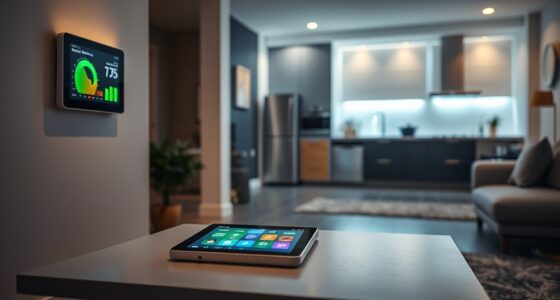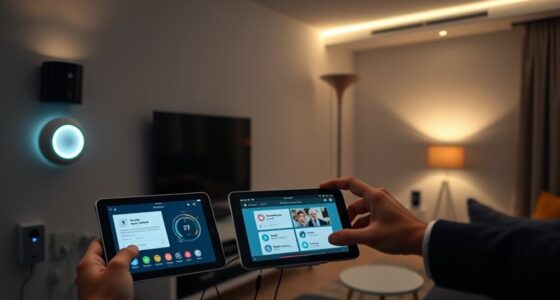Creating a big-screen home theater on a budget is achievable by combining DIY soundproofing and strategic projector placement. Use thick rugs, heavy curtains, or DIY foam panels to improve acoustics without costly upgrades. Position your projector carefully to optimize image size and clarity, experimenting with angles and distances. Focus on these simple modifications to transform your space into an immersive cinema experience, and you’ll discover even more tips to enhance your setup as you explore further.
Key Takeaways
- Use DIY foam panels and thick curtains to improve acoustics and soundproofing without costly renovations.
- Experiment with projector placement and angles to maximize screen size and clarity on a budget.
- Fill bookcases with books or add mass-loaded vinyl to walls for effective, inexpensive sound barriers.
- Opt for affordable, high-quality projectors and screens suited for small spaces to create a cinematic experience.
- Combine strategic soundproofing with DIY decor to enhance immersion and minimize noise disturbances cost-effectively.

Next, soundproofing techniques are vital for immersing yourself in your movies without disturbing others or being disturbed by outside noise. You don’t need professional-grade soundproofing—simple, cost-effective methods work just fine. To start, add thick rugs or carpets to your room floor; they absorb sound and reduce echo. Hang heavy curtains over windows, which help dampen sound and improve acoustics. You can also hang acoustic panels or DIY foam panels on walls to prevent sound from bouncing around and leaking out. Sealing gaps around doors and windows with weatherstripping or draft stoppers also helps keep noise where it belongs—inside your theater room. If you want to go a step further, consider building a makeshift sound barrier using bookcases filled with books or installing mass-loaded vinyl on walls. These techniques don’t require a major renovation but greatly enhance the sound environment, making your home theater more immersive. Additionally, understanding soundproofing techniques can help you optimize your setup for the best audio experience.
Combining proper projector placement with effective soundproofing techniques transforms a basic room into a dedicated movie space. You don’t need expensive equipment or professional installers to get great results—just a bit of planning and some DIY effort. Think about how you want to use the space, experiment with different projector angles and distances, and make sure your soundproofing measures are in place to enjoy movies, games, or sports without interruptions. With these simple tips, you’ll enjoy a big-screen experience that rivals commercial theaters, all within your budget. Creating a home theater on a budget is entirely doable when you pay attention to details like projector placement and soundproofing, bringing cinema-quality entertainment into your home without the hefty price tag.
Frequently Asked Questions
How Can I Improve Sound Quality Without Expensive Equipment?
To improve sound quality without splurging, focus on soundproofing techniques and speaker placement tips. Use rugs, curtains, and furniture to reduce echo and prevent sound leakage. Position your speakers at ear level and avoid placing them near walls or corners to enhance clarity. These simple adjustments make a big difference in audio experience, ensuring you get richer, clearer sound without investing in expensive equipment.
What Are the Best Budget-Friendly Projectors for a Home Theater?
When choosing a projector, look for the best cost-effective projectors that offer clear images without breaking the bank. Budget-friendly options like the Anker Nebula Capsule, ViewSonic PA503W, or Epson VS250 deliver good quality at a lower price. You can enjoy a big screen experience without overspending by comparing features and reviews, ensuring you pick a projector that fits your space and budget perfectly.
How Do I Hide Wires and Cables Neatly?
To hide wires and cables neatly, focus on effective cable management and concealed wiring techniques. Use cable raceways or conduits to run wires along walls or baseboards, keeping them out of sight. Velcro or zip ties help bundle cables for a clean look. For a seamless appearance, consider installing in-wall cable management systems, which hide cables behind the wall. This creates a tidy, professional home theater setup without clutter.
Can I Build a Screen With Materials I Already Have?
Imagine transforming your living room into a cinematic haven with a DIY screen using household materials. Yes, you can build a DIY screen with items you already have—think a stretched white sheet, a wooden frame, or even cardboard for a smaller setup. Just guarantee the surface is smooth and white for the best picture. With a little creativity, your budget-friendly, homemade screen will bring movies to life effortlessly.
What Lighting Options Work Best for a DIY Home Theater?
For your DIY home theater, lighting plays a key role in creating the right ambiance. You should consider using LED strips, which are flexible, easy to install, and can be placed behind your screen or along walls for indirect lighting. Dimmable bulbs are also a great choice, allowing you to adjust brightness for movie nights, reducing glare and enhancing image quality. Both options help set the perfect mood without breaking the bank.
Conclusion
Creating your home theater on a budget isn’t just about saving money; it’s about crafting a personal sanctuary where every movie night feels like a blockbuster event. With a little creativity and effort, you transform a simple space into a cinematic escape—proof that dreams don’t need to break the bank. So, take the plunge, because your perfect home theater is just a DIY project away, waiting to turn your living room into the star of your home.









